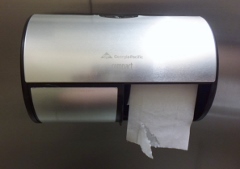The Two-Bin Inventory Control System

So what is a two-bin inventory control system? Whether you realize it or not, you are probably very familiar with the concept. In fact, if you are reading this on a tablet or smartphone, you may be sitting next to one right now (see photo).
According to Investopedia.com, the two-bin system is mainly used for small or "low value" items. (While we're not here to debate the value of toilet paper to western society, this blogger, for one, believes that Investopedia seriously underestimates it.) Here's how a two-bin system works:
- Two identically sized bins are used to hold the item in inventory.
- When the first bin is empty, this triggers an order to refill the bin.
- Meantime, the second (full) bin is used to supply demand until the replenishment order is filled.
Size of the bins is determined by factors like the rate and variability of demand, and the desired service level (i.e., percent of time demand is fulfilled). You want the bin to hold enough inventory to cover demand until the empty bin is replenished.
Instead of needing to hire a toilet paper forecaster to generate daily (or even hourly) demand forecasts for each stall, you only need to know things like the average rate of consumption (squares per hour), variability of consumption, and perhaps maximum rate of consumption due to special circumstances (a particular menu item in the cafeteria, or a stomach virus going around). With this information, you can determine the roll size (number of squares) and frequency of monitoring the bins, in order to maintain the desired service level.
What Do You Do When You're Stranded and There's Nothing on the Roll?
While fulfilling demand 100% of the time is a pleasant thought, it isn't always possible. But in multi-stall restroom facilities, the user may have the option of pulling supply from next door, as we learned in "The Stall" on Seinfeld. This is analogous to a transfer of inventory between stores -- perhaps an awkward and costly action, but effective to mitigate the impact of stock outages.
Brother, can you spare a square?

5 Comments
"Two-bin" sounds so much better than (s,S)-policy which is what this type of rule is typically called in inventory management, with s being the reorder point and S being the order-up-to level or basestock.
Plus I like the metaphor with the toilet paper.
Thanks Nils, for providing educational content, and for keeping the level of conversation at a dignified level. Unlike that second commentator, one Ms. Behme.
Great blog! You know Cheryl Crow says you only need 3 squares. Do your part to save the planet. Oh yeah, you were talking about forecasting.
Just 3 squares? I'm no gastroenterologist, but it sounds like she needs more fiber in her diet...or would that be less fiber?
Pingback: Don't touch that dial! Stop fine-tuning your forecast